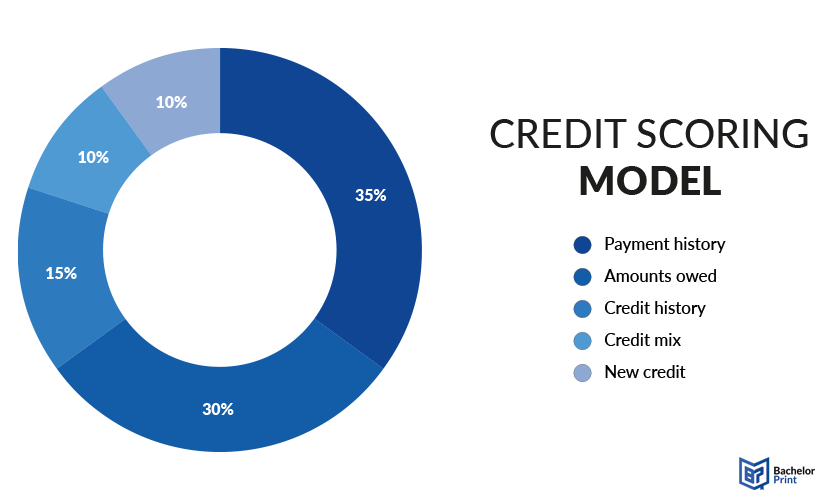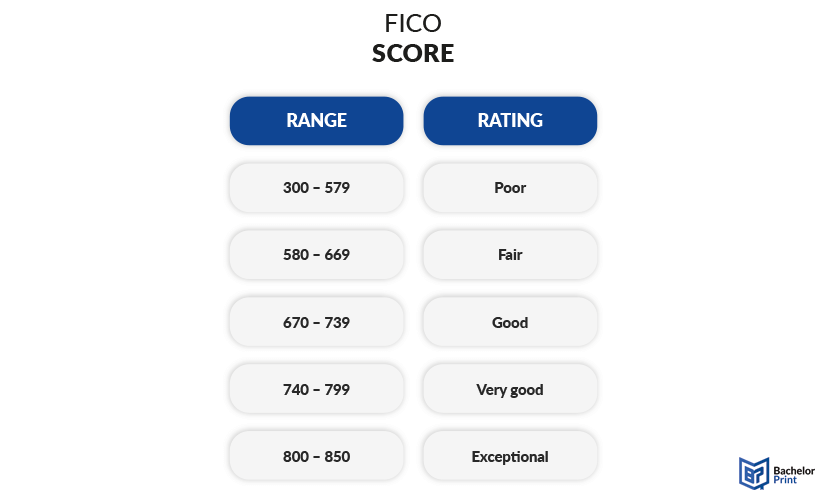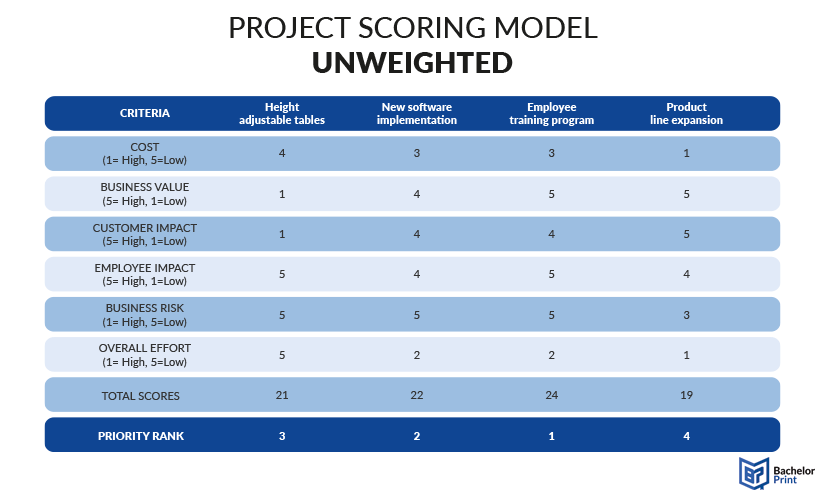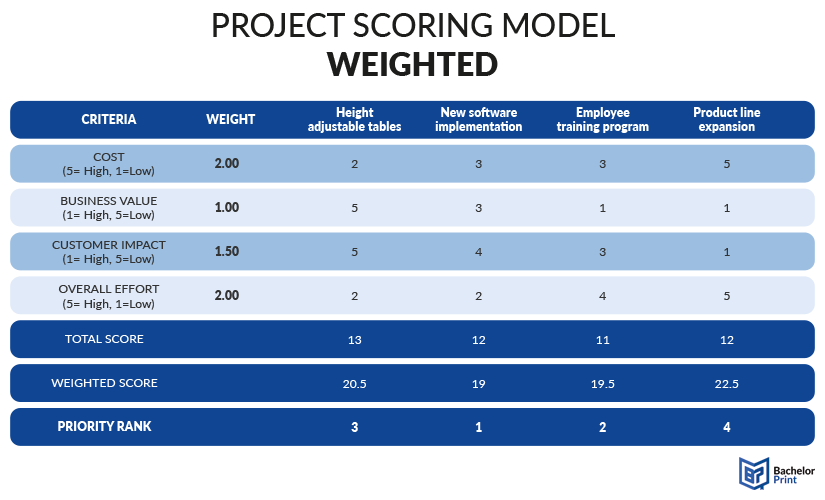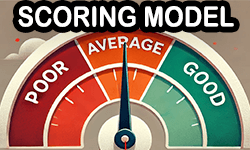
A scoring model is a crucial scoring matrix for institutions of higher learning when it comes to selecting students to join their courses. This robust methodology systematically evaluates and ranks applicants based on specific criteria by assigning numerical scores to various attributes. In this article, we’ll evaluate the benefits and uses of this scoring process while diving deeper into this systematic approach.
Definition: Scoring model
A scoring model is a systematic method used to rate and rank items, individuals, or entities based on specific criteria. During the scoring process, one assigns numerical scores to various attributes, allowing for a quantifiable comparison. Scoring models are commonly used in various fields such as finance, marketing, education, and project management to make informed, multifaceted decisions. Widely adopted in admissions procedures, these models enhance the accuracy and fairness of candidate evaluations, ensuring that institutions can identify and admit the most qualified students. By leveraging this structured scoring process, higher education institutions optimize their selection process, contributing to better academic outcomes and institutional success.
Uses of a scoring model
As mentioned before, this systematic scoring process can be used in various fields for all kinds of decisions, which we will get further into in this paragraph.




Credit scoring
Financial institutions use this model to evaluate the creditworthiness of loan applicants. Factors such as credit history, income, and debt levels are scored to determine the likelihood of repayment.
Lead scoring
In marketing, scoring frameworks help prioritize potential customers (leads) based on their likelihood to convert into paying customers. Attributes such as engagement level, demographic information, and past behavior are considered.
Project prioritization
Organizations and companies often use a scoring method to prioritize projects based on criteria like potential return on investment, strategic alignment, and availability of resources.
Performance evaluation
Education institutions and workplaces use scoring models to assess the performance of students or employees based on various metrics. This will help them concentrate on students or employees that meet their admission criteria.
What exactly is…
Credit scores are a global phenomenon, although the specific systems, bureaus, and scoring ranges can vary significantly from one country to another in the form of a percentile score or a numbered one. Typically, a credit score comes in the form of a 3-digit number that reflects the probability that an individual will repay their debt. This probability is determined by past borrowing and payment behavior, including the repayment of debts on time and the management of liabilities on time.
While format and score range can vary, generally the higher the number, the better, and a poor score can negatively impact your ability to secure loans, result in higher interest rates, and limit access to certain financial products and services.
Below, we have created an image with the five main categories of credit activity that make up your credit score, as well as an image illustrating the range and rating of the popular FICO score.
A lead scoring model is a popular method used by sales and marketing teams to determine how likely their customers (leads) are to make a purchase. The perceived value to the organization is determined by assigning scores to explicit and implicit attributes exhibited by the leads.
Explicit lead scoring is based on information that the lead provides directly, such as demographic and firmographic data. Implicit lead scoring, however, is based on the observed behaviors of the lead with your brand. This can be collected through tracking the lead’s online activities, engagement, and other indirect signals. The so-called matrix model combines both explicit and implicit lead scoring. The importance of those explicit and implicit traits varies based on your ideal client profile (ICP).
Below, you’ll find an image containing two sample lead scoring frameworks for businesses. Both positive and negative point values are depicted to make decision-making easier.
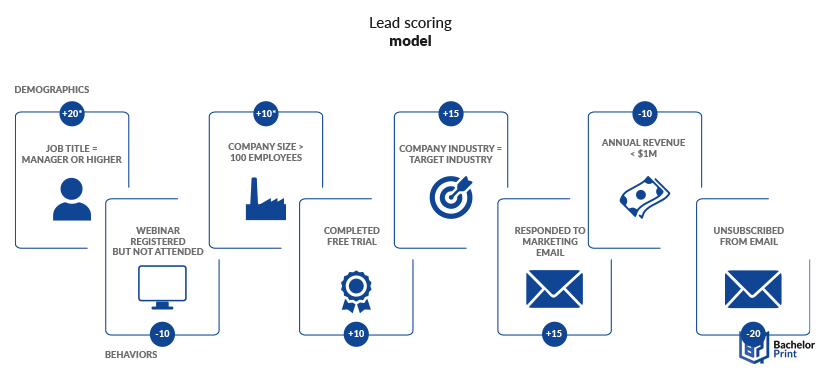
Project prioritization is a project scoring model used by organizations to evaluate and rank projects or project decisions based on several criteria to determine which projects or tasks should be pursued first. A project manager may use survey research or a simple template to determine the key factors for each respondent of the team. One should choose up to five of the most crucial project criteria and consider the weight to each criterion based on its importance.
When deciding between two options, the Eisenhower Matrix is the way to go. If all the options are equally critical, using a pairwise model that compares projects or tasks in pairs until an overall completion ranking is determined. If each selection criteria holds the same level of importance, pick a scoring matrix to determine each option’s relative importance. This prioritization matrix is a grid where each cell represents the score, each row represents a project or task, and each column represents a criterion used for evaluation.
If none of this fits, you can use a weighted scoring matrix (or a weighted decision matrix) that is an advanced version of a scoring matrix. Each criterion is assigned a weight based on its importance, and the individual scores for each criterion are multiplied by these weights before being totaled.
Below, we have created examples of both a simplified and a weighted scoring model for project selection. The first example is for business projects, while the second example is for student projects.
A performance evaluation model refers to the systematic assessment of an individual’s or organization’s performance based on predefined criteria. This method involves assigning scores to various performance attributes, which are then aggregated to provide an overall performance score. This scoring model is especially popular for educational institutions to evaluate academic performance, class participation, attendance, behavior, and extracurricular activities.
The 360-degree feedback model (or multi-rater feedback) is an employee evaluation method that collects input from several sources about an employee’s performance and areas of improvement and turns the data into a scoring scale. This input can include self-evaluation, feedback from peers, customers, supervisors, and subordinates. All feedback sources can be used individually; however, the multi-rater feedback provides a holistic view of an individual’s performance.
Below, we have created a sample image for the performance evaluation scoring framework.
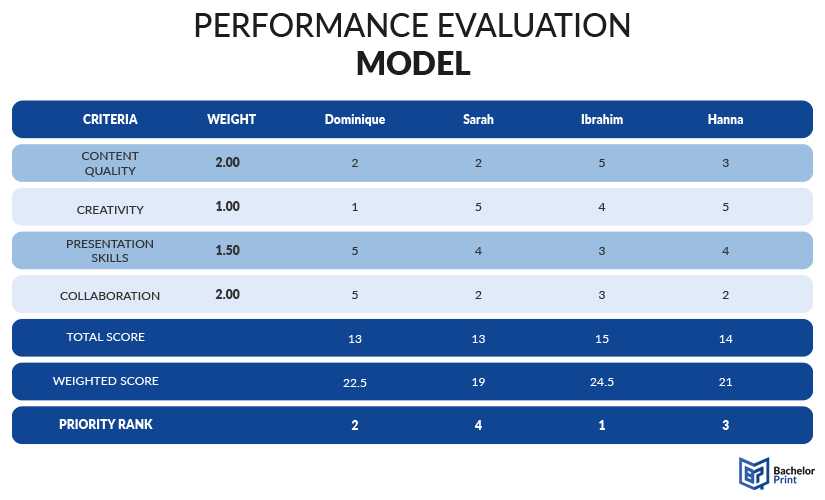
Calculating a scoring model
Before you can systematically evaluate and rank options based on your criteria, you first need to decide between the weighted scoring framework and the unweighted scoring framework. In a weighted scoring model, each criterion is given a weight that reflects its relative importance. The scores for each criterion are then multiplied by these weights before summing them to get the total score. As mentioned before, this can be quite useful for objective prioritization decisions. Now that you know which technique benefits your decision-making, let’s list all steps.
- Identify the criteria that are relevant to the evaluation. These criteria should reflect the goals and priorities of the decision-making process.
- (Optional) Assign weights to each criterion based on importance. This step ensures that more critical factors have a greater influence on the overall score.
- Evaluate each option against the defined criteria. Assign a score to each option for every criterion using a consistent scale (e.g., 1-10).
- (Optional) If weights have been assigned, multiply each score by its corresponding weight to get the weighted scores.
- To determine the overall performance of your scoring, sum the scores (or weighted scores) for each option to get the total score of your scoring framework.
- Rank the options based on their total scores to determine their priority. The option with the highest total score is given the highest priority.
Benefits of a scoring model
Now that we have shown the different types of scoring models and how to calculate them, it is time to look at the benefits that can arise.
Objectivity
Scoring models provide a systematic approach to evaluation, which in turn reduces biases and subjectivity in decision-making.
Quantitative analysis
It facilitates data-driven decision-making and allows for easy identification of top priorities or candidates.
Efficiency
Scoring models save huge amounts of time and resources, especially when dealing with numerous candidates, projects, or alternatives.
Student-related benefits
It supports personalized learning, improves academic outcomes, and ensures that support services are directed where they are needed.
Employee satisfaction
Scoring models can enhance satisfaction by ensuring that employee needs and feedback are systematically taken into consideration.
FAQs
The scoring model technique is a systematic method to evaluate and rank options based on multiple criteria, thus can make a decision process easier. Each option is assigned scores, which are then aggregated to provide an overall score.
- Define the criteria that are relevant to the evaluation.
- (Optional) Assign weights to each criterion based on importance.
- Evaluate each option against the criteria and assign a score for each criterion.
- (Optional) Multiply each score by its corresponding weight.
- Sum the scores for each option to get the total score.
- Rank the options based on their total scores to determine their priority.
It is used to rank and prioritize options, such as projects or tasks, based on multiple criteria that reflect their importance and impact. The model assigns scores to each option for different criteria, aggregates these scores, and ranks the options based on their total score.
One of the most commonly used scoring frameworks is the weighted scoring model. It allows for the assignment of different weights to various criteria based on their importance, making it versatile and adaptable to different contexts.

